Tender pork slices with a hint of ginger wrapped between layers of rice and nori, Ginger Pork Onigirazu makes an amazing menu for bento lunch!
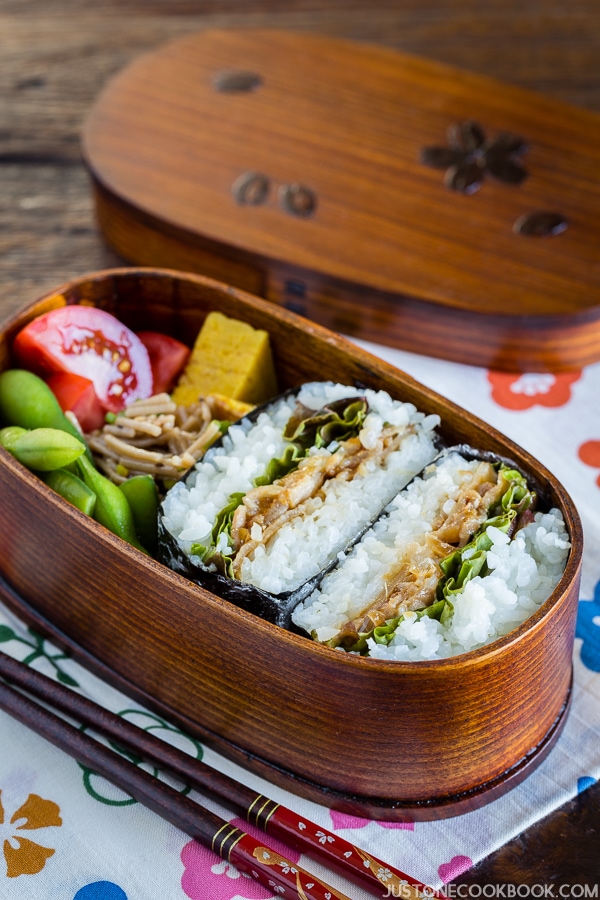
The new school year has started and if you need new inspiration for what to pack for yourself or your children, try this easy and flavorful Ginger Pork Onigirazu (豚の生姜焼きおにぎらず) in your lunch menu routine!
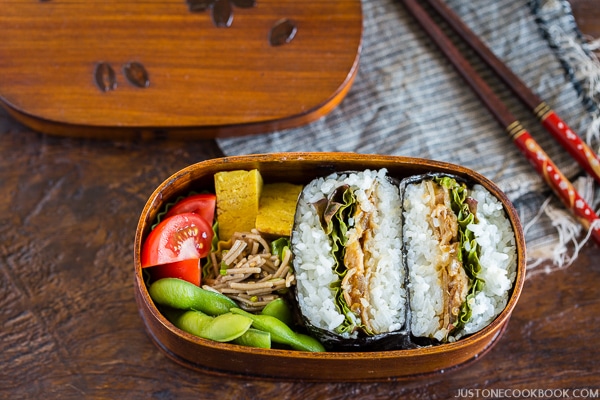
How to Make Ginger Pork Onigirazu
Ginger Pork or Buta no Shogayaki (豚の生姜焼き) is a Japanese dish that is often made at home or enjoyed at Teishoku-ya (lunch set menu restaurant) in Japan. This dish might be new to you as it’s not as well-known as Japanese Teriyaki dishes, so your local Japanese restaurants might not offer this on their menu.
However, if you love ginger and soft tender pork slices, I guarantee you’ll love this dish. It’s such an easy and quick dish to make for your busy weekday nights. If you are not a fan of ginger, you can reduce the amount (use just a hint of it). Please take a look at my Ginger Pork recipe for inspiration.
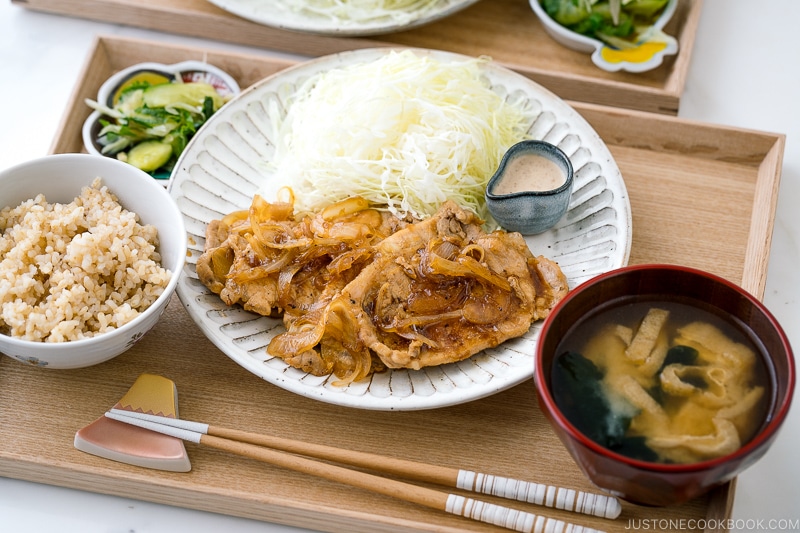
What is Onigirazu?
Onigirazu is a rice ball (onigiri or omusubi in Japanese) that is not formed into the traditional round or triangle shape. It is usually a square or rectangular shape. You “sandwich” the savory fillings with steamed rice, just like how you would make a sandwich with 2 pieces of bread.
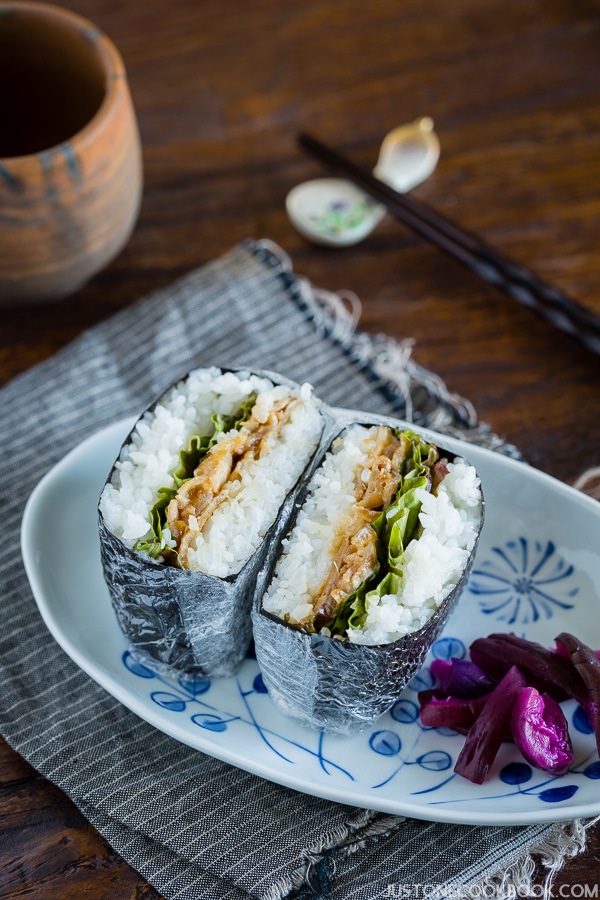
Unlike traditional ongiri or omusubi, you can put more fillings inside onigirazu than traditional rice balls as the shape is square/rectangular. You can also spread the fillings just like how you lay them out for a sandwich.
After you make the rice sandwich, you wrap it up with a sheet of nori and cut it in half to serve or pack in your lunch box (I use Magewappa – you can purchase a similar one here).
If you want to learn more about onigirazu and its origin/history, please read this post.
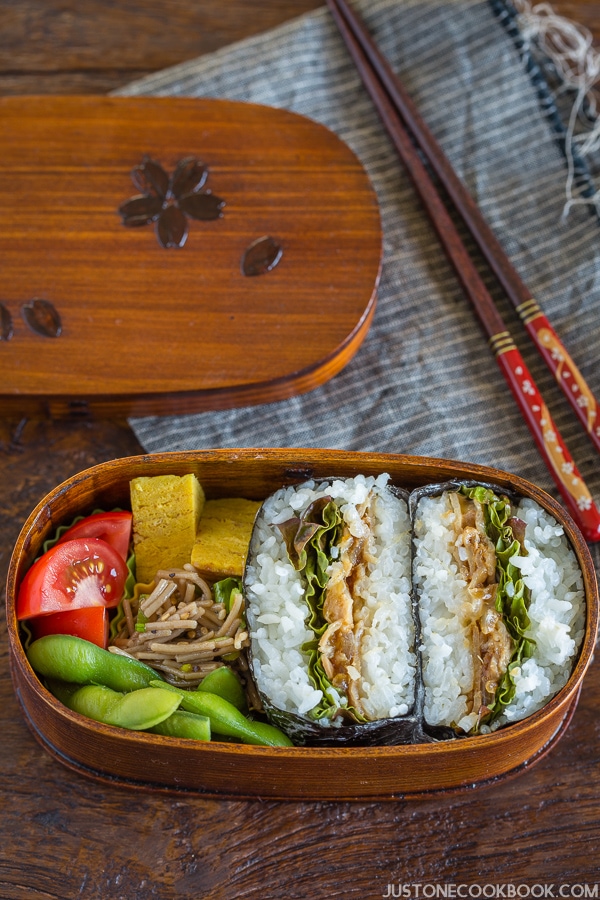
Onigirazu Mold for Ginger Pork Onigirazu
Many of you have asked me about my wooden onigirazu mold. This beautiful mold was a gift from Mark, a JOC reader from Oregon. He handcrafted this mold with Port Orford cedar and there is not a single nail used in this mold! For those of you who are interested in this mold, please check out his Etsy page!
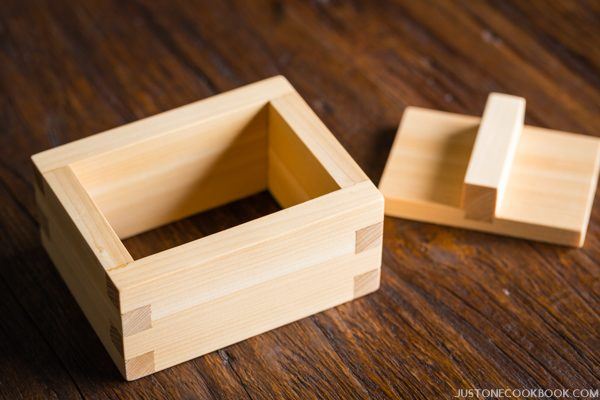
If you want to check out other bento ideas, read 15 Back to School Easy Bento Ideas & Recipes.
Wish to learn more about Japanese cooking? Sign up for our free newsletter to receive cooking tips & recipe updates! And stay in touch with me on Facebook, Pinterest, YouTube, and Instagram.
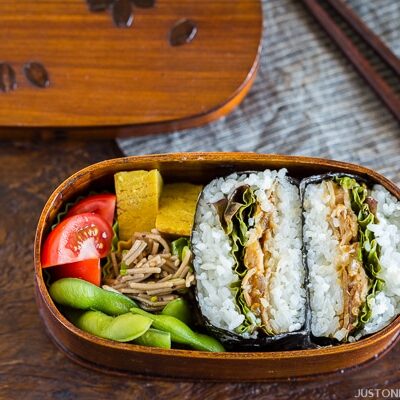
Ginger Pork Onigirazu
Ingredients
- 1 sheet nori (dried laver seaweed)
- 1 cup cooked Japanese short-grain rice (warm)
- Diamond Crystal kosher salt
- 1 leaf lettuce
- Japanese Kewpie mayonnaise
- shogayaki (ginger pork) (you can make my Ginger Pork recipe)
Instructions
- Gather all the ingredients. For the steamed rice, see how to cook short-grain rice with a rice cooker, pot over the stove, Instant Pot, or donabe.

- Place a sheet of plastic wrap on a working surface. Place 1 sheet nori (dried laver seaweed) on top (shiny side facing down) with a corner pointing up. For this recipe, I shaped my onigirazu using an onigirazu mold; however, you can neatly layer the ingredients without one as well. Evenly spread ½ cup cooked Japanese short-grain rice in a thin layer in a square/rectangular shape in the center of nori sheet. Sprinkle with a little bit of Diamond Crystal kosher salt. Salt has two purposes for this recipe. First, it adds flavor. Secondly, salt prevents the food from spoiling as we eat onigiri, onigirazu, and bento at room temperature, and typically without refrigeration.

- Place 1 leaf lettuce on top of the rice and drizzle with some Japanese Kewpie mayonnaise. Then, put the shogayaki (ginger pork) on top. When you add the fillings, consider how you will cut the onigirazu later. You want to arrange the fillings so when you slice the onigirazu in half, the ingredients are revealed in a way that looks delicious.

- Place ½ cup cooked Japanese short-grain rice on top, maintaining a nice square/rectangular shape. If you have an onigirazu mold, moisten the “lid” before you press down so the rice does not stick to it. Place the lid on top and press gently.

- Pull up the mold carefully while pressing down on the lid. If you’re not using a mold, make sure to stack the ingredients nicely.

- Bring the left and right corners of the nori sheet towards the center. Fold gently but tightly to wrap around the rice and filling at the center. Then bring bottom and top corners towards the center. Continue to fold gently but tightly around the layers. Make sure the rice is tucked in nicely. If your onigirazu is a square shape, you can mark the onigirazu with a rice kernel so you will remember which way you want to cut later on.

- Wrap tightly with the plastic wrap. Set aside for 5 minutes with the nori’s seam side down. After 5 minutes, cut the onigirazu with a sharp knife. Run your knife in running water before cutting so that the cross-section will be clean.

- If you plan to make this the previous night, wrap the onigirazu with a kitchen towel and keep it in the refrigerator overnight (with the plastic wrap on). The towel will prevent the rice from getting hardened due to the cold temperature. Eat within 24 hours.

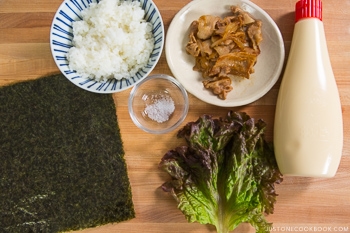
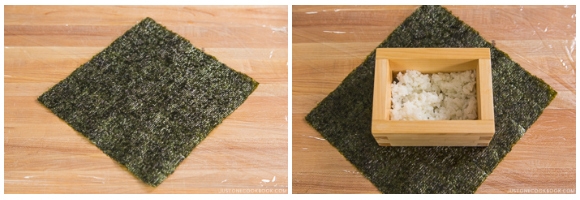
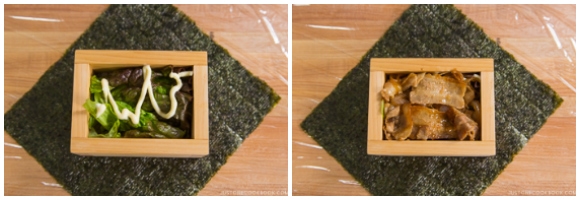
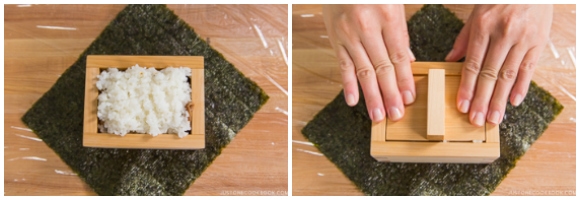
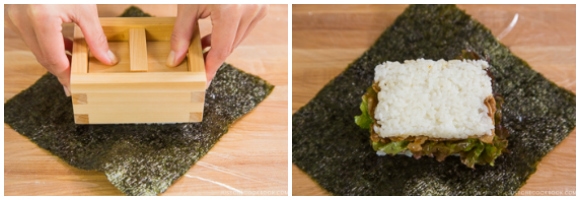
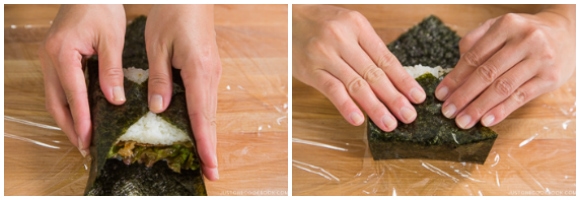
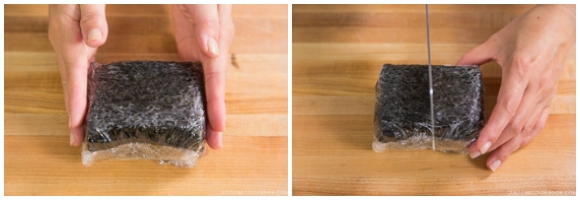
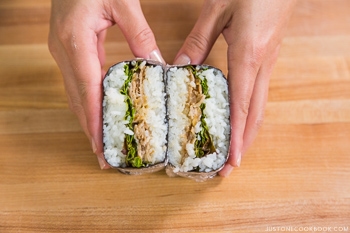










Hi Nami,
I love your recipes and would love to try this for my kid’s lunch. I have some questions:
1. In the past whenever I tried making sushi at home, the seaweed would get soft and no longer crispy after 1 or 2 hours. Is there a solution for this?
2 Does the piece of seaweed have to be toasted first?
Hi Zen! Thank you so much for your kind words.
1) No, nori gets wilted and stale as soon as it’s left out (even without touching the rice). Rice has moisture, so the nori will just absorb all the moisture from the rice. No sushi rolls have crisp nori around it.
2) Yes, you definitely can, but that’s for fragrance and make it crisp. It’s great if you are going to enjoy it right away… like wrapping rice ball and eat together -so it’s crisp. But for sushi rolls or onigirazu, you have to wrap around it… so… you should do it just for fragrance.
One recommendation about nori. Get really good quality. You will see the difference between expensive and cheap nori. Cheap ones tend to be chewy and you may not be able to chew off. It’s pretty bad (at least ones we can get here that’s cheap). Japan has more various brands etc, but outside of Japan things can be limited… but splurge on nori. You will definitely enjoy the taste and texture. 🙂
Thanks for your reply! I will start looking out for good nori as recommended!
Hi Zen! I think you’ll notice the difference in the taste, texture, and fragrance right away. 🙂
[…] 10. Ginger Pork Onigirazu Bento […]
[…] 15. Ginger Pork Onigirazu Bento […]
[…] Ginger Pork Onigirazu […]
I have some leftover shogayaki so am going to make this for my family’ obento today! But I adore the 曲げわっぱ bento box you have! Every time we go to Japan I search for one like that but haven’t spotted ‘the one’. Did you buy that in Japan?
I bought it online, but you can purchase a similar one here that ships internationally:
http://anything-from-japan.com/kurikyu-odate-bentwood-lunchbox-slim-p-33?___store=default&nosto=nosto-page-category1
I do love your ginger pork!! I’ve made it before and served it with a simple rice. This sandwich looks awesome and even though I’m not a kid, I’d love one of these in my lunch box. Lucky kids you have!
I do need inspiration for my own lunch boxes! I have bought an onigirazu cookery book in Japan, but every experiment was just so messy…. I abandoned. I guess I must buy this wooden gadget! (A 101st item on my shopping list for the future trip!). Your onigirazu filling sounds fantastic. I am such a big fan of ginger pork… Thank you!
Dear Namiさん
I was so happy when I saw this post, as I had been thinking of the very same thing – to make Buta no Shogayaki Onigirazu!! I love Ginger Pork too! 😀 Just wanted to ask, do we need to reheat the Onigirazu if it was prepared the night before? Or can we just eat as it is without hearing it up?
Hi Kasumi-san! Ohh you must make this! I really love this combination, and as a shogayaki fan, I can eat this everyday! I don’t eat shogayaki with mayonnaise, but when it’s added in the onigirazu…. ohhh so good. The salty and sweet sauce goes well with a little bit of mayo… 🙂
It’s really up to you. If you keep in the fridge, I’d suggest to take out at least 30 mins to 1 hour before eating. Onigiri or Onigirazu are meant to eat at room temperature in Japan, not hot. If you eat it after taking out from the fridge, the rice can be cold and tough…. So I always suggest to wrap the onigirazu with kitchen towel and keep in the fridge so onigirazu doesn’t get too cold. 🙂 Hope you enjoy!
Dear Namiさん,
Thank you for your reply!! I’m glad to hear that, I can then prepare the night before and bring my favourite Onigirazu for lunch at work!! *\(^o^)/*
Also…I’ll be making Shogayaki Onigirazu for dinner tonight! ✨✌????️
Yay! Hope you enjoy! Have a great weekend! ありがとう〜!
どういたしまして! (^-^)♪
Have a great week ahead!!
Love that mold! And love the dish, too — so pretty. Thanks!
This is something I’ll make for Mia soon 😀